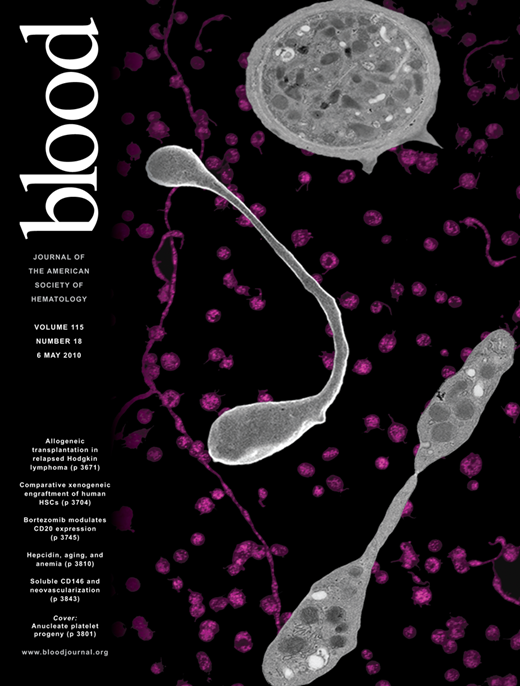In this issue of Blood, Scott-Algara and colleagues describe decreased surface expression with intracellular accumulation of CXCR4 in CD4+ T cells of 6 patients with ICL.1 This was associated with decreased migratory responses to CXCL12 and was restored by both in vitro and in vivo IL-2.
In this issue of Blood, Scott-Algara et al found that patients with idiopathic CD4 lymphocytopenia (ICL) had very low to undetectable levels of surface CXCR4 expression on CD4+ T cells and higher levels of intracellular levels of CXCR4 and its ligand, CXCL12, compared with healthy controls. The abnormally low CXCR4 expression was seen exclusively in T cells (predominantly in CD4+) including both naive and memory subsets. Overnight rest of the cells restored surface expression of CXCR4 to normal levels. In chemotaxis assays, it was shown that T cells from ICL patients had impaired chemotactic responses to CXCL12 and normal responses to CXCL8. Further experiments showed a slower reemergence of CXCR4 after ligand binding and internalization. Finally, in vivo interleukin-2 (IL-2) administration seemed to restore CXCR4 expression and responses to CXCL12 in 3 of 4 patients treated.
Seventeen years from the Centers for Disease Control and Prevention description and definition of ICL,2 the etiology or etiologies of this syndrome are unknown. Few studies have addressed the pathways potentially involved in perturbed CD4+ T-cell homeostasis, such as decreased clonogenic capacity of lymphoid progenitors,3 increased susceptibility of CD4+ T cells to Fas-mediated apoptosis,4 or defective p56Lck activity of T cells.5 Unfortunately, because of the rarity of this syndrome and the variable clinical presentations and acuity, most studies have relied on a small number of patients without structured longitudinal follow-up. Despite the consensus that ICL is a heterogeneous syndrome in both etiology and clinical manifestations, many immunologic observations appear to be consistent among patients, raising the question of whether they relate more to cause or effect.6
The role of chemokines and their receptors expands from organogenesis, trafficking of cells between tissues, and establishment of functional lymphoid microenvironments supporting homeostasis. Dysfunction of chemokine receptors or signaling can affect susceptibility to infections. CXCR4 and CXCL12 could thus play an important role in idiopathic T-cell lymphocytopenia, in terms of both pathogenesis and susceptibility to infections. Cause and effect conundrum aside, decreased CXCR4 expression and CXCL12 responsiveness may contribute to perturbed trafficking and homeostatic signals, further hampering T-cell function or expansion.
The limitations of this study were the small number of patients and the fact that all patients had ICL with an underlying significant infection (there were no clinically asymptomatic ICL patients and no patients with chronic infections but normal CD4+ T-cell counts as controls). In addition, there was no systematic evaluation for potential soluble factors that could play a role in CXCR4 down-regulation. It is unclear why the patients in this cohort did not have a decreased proportion of naive CD4+ T cells seen in previous studies3,4,6 that could have at least explained the decreased levels of CXCR4 expression.
Cytokine therapies (IL-2 and IFNγ) have been used to improve proliferation, increase survival of T cells, and facilitate clearance of infections with variable success in cases of ICL. The lack of clinical benefit, despite substantial CD4+ T-cell expansions with IL-2 therapy in HIV infection, has taught us that cytokine-induced CD4+ T-cell increases are not always clinically meaningful. Reversal of a specific T-cell defect in ICL would be a reasonable objective. Defects in chemokine receptors or signaling may thus represent a plausible immunotherapeutic target not investigated to date. Both IL-2 as shown here and IL-7 can up-regulate CXCR4 expression,7 so it will be important to determine whether the results of this study can be reproduced in other cohorts and whether clinical outcome correlates with these laboratory measurements. In conclusion, Scott-Algara et al have opened up a new area of investigation in ICL, both from the pathogenesis and etiology standpoint and from the therapeutic perspective. More data are needed to validate these findings in other cohorts and to further evaluate potential underlying genetic defects or soluble factors that may be responsible for these observations.
Acknowledgments
The author would like to thank Drs Philip M. Murphy and Michail S. Lionakis for interesting discussions. This work was supported by the Intramural Research Program of the National Institute of Allergy and Infectious Diseases, National Institutes of Health.
National Institutes of Health
Conflict-of-interest disclosure: The author declares no competing financial interests. ■

